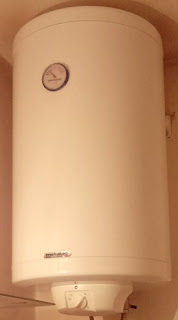How can I found problem that cause my boiler to stop working?
Well it is a good question and we always recommend you to call a electrician but... You know that this can happened at any time of the day and sometimes you'll need to wait long for electrician to come. So maybe this is a small problem that you can fix by yourself and there is nothing so complicated in boiler. It is not a spacecraft right?
So more work less talk.
You know that basics elements of any boiler are: security thermostat, heater, regulation thermostat, and signal bulb. That's all so there is nothing difficult here.
You have electric circuit that starts from your el. network, goes to the boiler's terminals, then current goes through security thermostat, then through working thermostat (the one where you regulate heat with plastic wheel) and finally comes to the heater and heat water.
So if any of these components fail you will have your boiler fail as well.
What can cause fail of components?
Usually it is an old installation that fail over time so if that cause your boiler to fail you will need to change some wires and connectors.
Another common problem is heater of the boiler. Heater suffer a lot of stress while heating water and if you have a "hard" water in your house that will cause lime scale deposits to build on heater and destroy heater over time.
And beside these two problems you can get failure of one of two thermal elements.
Now how to determine which one of the components fail?
1. Check wires and installation
If you have problem with old wires you can see that already when you open your boiler and access to installation. Every wire that looks damaged need's to be changed, every connector too.
2. Check heater
If your wires are OK and you can't see nothing unusual then you better check heater. To do so you will need a ohmmeter. First take off two wires from heater and measure resistance with instrument.
If you have any resistance on heater then heater is fine, just reconnect heater as he was before.
3. Check security thermostat
You also need ohmmeter so procedure is simple, just check that security thermostat have resistance close to zero on both ends for "null" and for "phase" line.
4. Check working thermostat
This is also simple, take your ohmmeter and measure resistance on thermostat when it is "off" and after that when you turn it "on". You usually hear "click clack" sound when you turn him off or on.
So when he is turned "OFF" you should not have any resistance shown on ohmmeter and when you turn thermostat "on you must have resistance close to zero.
So that's it, simple as that so if you have any questions feel free to comment below.



No comments:
Post a Comment